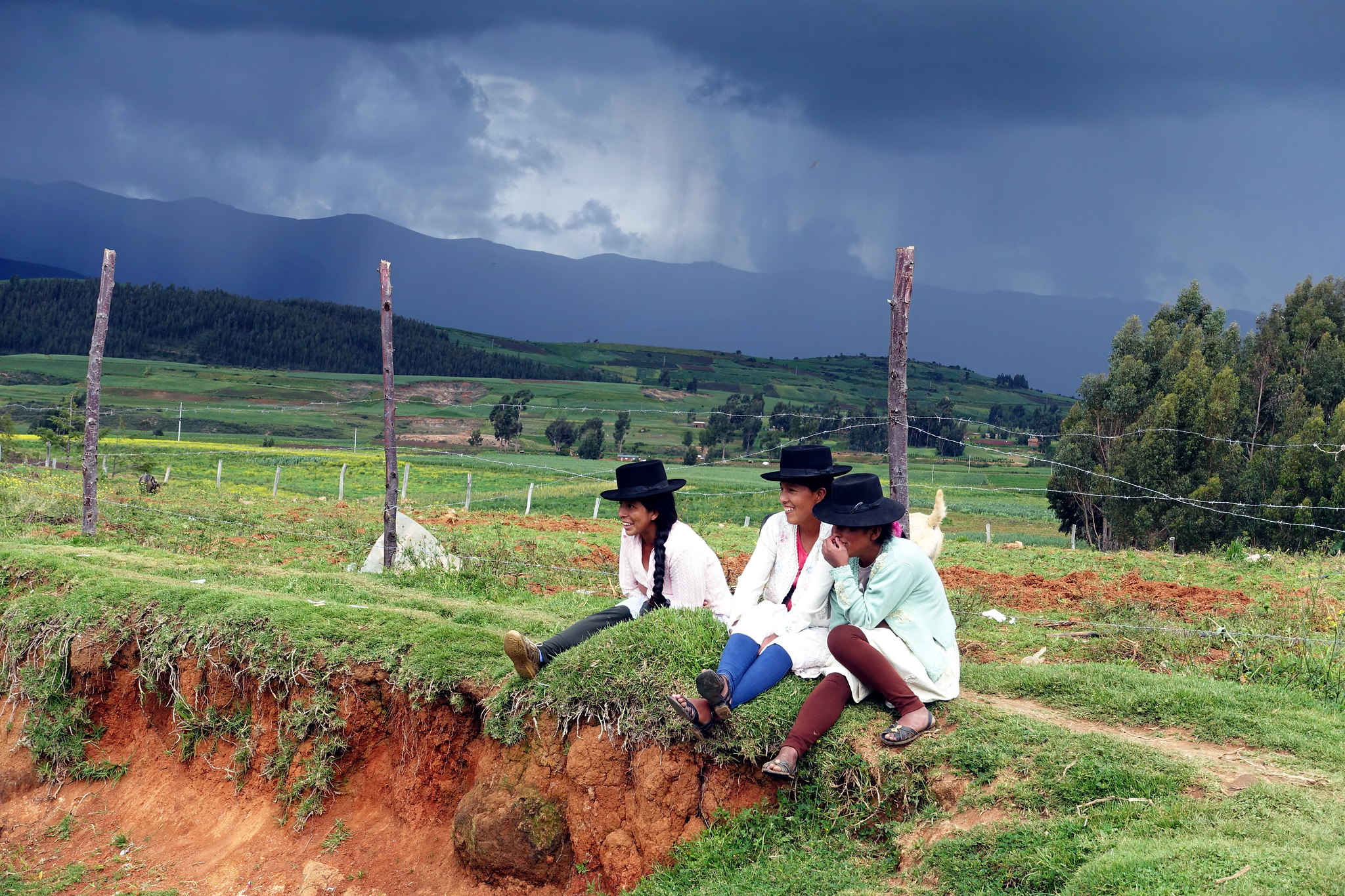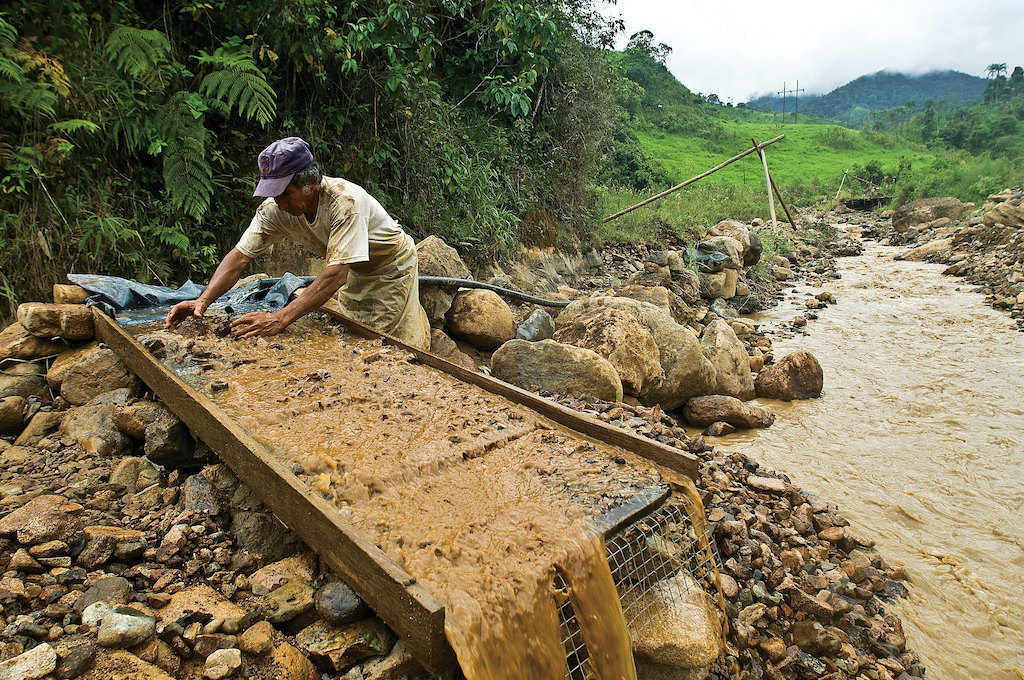The authors describe some of the issues facing women from mining communities based in Andean-Amazonian countries, focusing on how exposure to mercury poses several risks to their overall health. They outline the importance of adopting a gendered approach in the formulation and implementation of public policies concerned with the health of communities living in mining territories.
In Latin America, aggressive extractive practices, such as gold and oil mining and fracking, transform the landscape of Indigenous, Afro-descendant and rural territories, affecting their access to key resources such as water and land. Beyond having violent socio-economic and political impacts, the usage of chemical contaminants in these practices generates a significant impact on the health of communities living in extractivist territories. In Latin America, artisanal gold-mining constitutes the main livelihood strategy for more than 2.2 million women and men, who rely on mercury usage to obtain gold. This sector is responsible for up to 71% of the total mercury (Hg) emissions into the environment, thereby threatening the health of miners and the communities living in mining territories. These releases are concentrated in the Andean-Amazonian countries (Colombia, Ecuador, Peru, and Bolivia), with Colombia being the highest per capita mercury polluter of the world, and releasing up to 180 Hg tonnes of mercury annually into the atmosphere.
The severity of the impacts of mercury on human health depends on the route of exposure, its frequency and on the person’s body-weight. Exposure to mercury has been correlated to changes in the nervous system, deterioration of the visual and auditory capacities, kidney and brain damages and psychiatric symptoms. Moreover, mercury poses severe risks to women’s sexual and reproductive health, and several epidemiological studies report that exposure to this chemical can lead to miscarriages, alterations of the menstrual cycles, infertility and breast cancer. Moreover, elemental mercury has the capacity to cross the placental barrier and prenatal exposure to methylmercury can impact the development of the foetus and generate foetal neurotoxicity. Mercury also gets accumulated in breast milk and breastfed infants can be exposed to contamination from this source.
Efforts and initiatives to control or, if possible, eliminate mercury usage are increasingly becoming part of the global health and environmental agenda. In 2013, 24 Latin American and Caribbean countries signed the Minamata Convention, “to protect human health and the environment from anthropogenic emissions and releases of mercury and mercury compounds”. Yet, environmental policy-makers and national governments fail to address women’s differential vulnerability to mercury, considering not only its biological but socio-economic determinants and the intersectional factors that shape gendered exposure and exacerbate existing inequalities. Moreover, the gendered struggles elicited by mercury contamination in mining territories are often overlooked.
Intersectional vulnerability
The Minamata Agreement calls on national governments to formulate, “strategies to prevent the exposure of vulnerable populations, particularly children and women of child-bearing age, especially pregnant women, to mercury used in artisanal and small-scale gold mining”. However, in the text of the agreement, women’s vulnerability to mercury is mainly understood in relation to women’s reproductive biological functions, which could be compromised by mercury. The intersectional social and economic factors that determine exposure to mercury in the first place and, in particular, the lack of livelihood choices that forces low-income women, usually from Indigenous or Afro-descendant background to enter the sector of artisanal gold-mining, fail to be investigated.
An important factor that determines women’s vulnerability to mercury is their participation in artisanal gold mining and their subaltern role in this sector. In fact, despite being usually conceived as a male-led activity, gold-mining represents a significant livelihood strategy for rural women across the world and, in particular, in Latin America. Official data on women’s participation in artisanal gold mining is scarcely available, but they are estimated to constitute around 30% of the global workforce in this sector. In Bolivia, this percentage corresponds to around 22% of the workforce and in Ecuador to the 8%. Women’s participation is determined by the lack of capital and investments required to practice open-access mining and mining represents one of the few livelihood strategy available to women living below or close to the poverty line. Even though mercury is rarely directly employed by female miners, the practice of mining in open access sites, like rivers, exposes women’s bodies to the discharges of mercury produced by more profitable, usually male-led, mining activities.
The intersectional social and economic factors that determine exposure to mercury in the first place and, in particular, the lack of livelihood choices that forces low-income women, usually from Indigenous or Afro-descendant background to enter the sector of artisanal gold-mining, fail to be investigated.
Beyond directly affecting male and female miners, traveling in rivers and the atmosphere, mercury also reaches those communities that live nearby mining sites. In fact, once released into the atmosphere through the burning of the “amalgama”: the mixture of gold and mercury can travel long-distances and get deposited through rain or dust aggregation[1]. Moreover, mercury can be discharged directly into water during the process of washing the extracted material and gets accumulated in river sediments and fish fat tissues. Given the geographically widespread and long-term impacts of mercury on the landscape, women living in mining territories are also exposed to mercury through water and fish consumption. This is particularly true in communities exposed to severe food insecurity, where people could be aware of the risks involved in consuming contaminated fish, but this may be the only available source of proteins. Mining sites are also often located in ethnic territories and exposure to mercury reinforces a pattern of uneven racial distribution of environmental hazards, Moreover, given their often-remote geographical location, mining communities also usually lack access to health services, which constitutes an additional vulnerability for women and communities exposed to mercury contamination.
A gendered struggle
Women living in mining territories often have little decision-making power in the household and at the community level and mercury usage elicits a gendered struggle. In fact, mercury is mostly used by male miners, in labour-intensive mining practices such as reef mining, in the process of washing the extracted material in water mills. On the contrary, women, who often lack formal permits to mine, generally work in open-access sites such as rivers, where they practice traditional forms of mining that do not require mercury usage. Women who do not practice mining independently, often travel to male-led mining sites to support the work of male members of their households. These tasks include cooking food or performing simple tasks such as carrying residual materials outside of the mining site.
Women performing these tasks are equally exposed to the inhalation of mercury when the “amalgama” is burnt, but they usually lack control over the decision of employing mercury, as their role is only to provide help to male miners. As mining is generally conceived as a masculine activity, women are also generally excluded from sensibilisation campaigns and training opportunities offered to informal miners and they have less access to information on the dangers of mercury usage. In artisanal gold mining communities, the practice of burning the “amalgama” often occurs in the domestic space of the miner’s house, exposing women who are not directly involved in mining practices and children to the inhalation of mercury. Ethnographic studies relate that, in some territories, women perceive the practice of the burning of the amalgama as an invasion of their domestic space[2].
Conclusions
Mercury contamination represents a public health issue, but also an important socio-political and gendered challenge. Women’s vulnerability to mercury is determined by political and socio-economic factors that need to be addressed. Exposure to mercury contamination reproduces gender and racial inequalities that are inscribed in the geography of gold-mining activities. Moreover, mercury usage, which is mostly a male-led practice, elicits a gendered struggle at the community and household level, and women’s exclusions from decision-making processes at both the community and the household level needs to be addressed as an additional factor that determines their vulnerability. The recently gained visibility of women’s role in artisanal gold mining suggests the importance of adopting a gendered approach in the formulation and implementation of public policies concerned with the health of communities living in mining territories.
References
[1] Lin, C. J., & Pehkonen, S. O. (1999). The chemistry of atmospheric mercury: a review. Atmospheric environment, 33(13), 2067-2079.
[2] Vélez-Torres, I., Vanegas, D. C., McLamore, E. S., & Hurtado, D. (2018). Mercury pollution and artisanal gold mining in Alto Cauca, Colombia: woman’s perception of health and environmental impacts. The Journal of Environment & Development, 27(4), 415-444.
The views expressed in this post are those of the author(s) and in no way reflect those of the Global Health Initiative blog or the London School of Economics and Political Science.
Photo: Artisanal gold miner. Credit: Knut-Erik Helle. Licensed under creative commons (CC BY-NC-ND 2.0).





